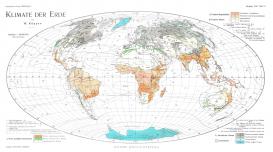"Data That Travel: Climates Between Africa and Europe" examines the conditions of climatological data collection efforts in colonial Africa and the processes of selection and translation that occurred between the sites of recording and publication. The project focuses particularly on the everyday practices and difficulties of both European and African practitioners in the colonies. While governmental policies aimed at producing standardized—and thus globally comparable and economically useful—data in different environments, these efforts often tended to break down in practice. Rather than being able to turn the field into a finely tuned laboratory, the data gatherers were confronted with complex and challenging infrastructural, institutional, and environmental realities—ranging from the lack of instruments to unknown meteorological phenomena—and had to develop place-specific strategies to deal with these issues.
The difficulties of meteorological work in the colonies led not only to the production of often-questionable numerical data but also to alternative strategies of recording weather conditions, which often placed a higher value on individual sensory perception than instrument-recorded data series. These qualitative data, however, fit neither the needs of scientific publications in Europe nor the requests of the colonial offices, and thus did not show up in either the maps and models of world climatic conditions or the government reports on the economic viability of overseas possessions. The pressures of both emergent trends in atmospheric science and political exigencies thus shaped the form and content of data that were allowed to travel freely between the colonies and the metropole. Ultimately, the project seeks to address the questions of what effects the increasing availability and dissemination of data from around the world had on definitions of climates around the turn of the twentieth century and how the spotty and diverse data from the colonies could eventually result in the smooth and gapless visualizations of climatic data in charts and on world maps.
My current book project, Deserts with History: From Climate Change to Changing Climates takes a close look at one particular aspect of the larger story of climatology, climate ideas, and environmental anxiety in the nineteenth and twentieth centuries. It examines the role that colonial arid environments played in inspiring climate change and climate engineering ideas from the 1870s to the middle of the twentieth century. The book traces the development of early climate change debates in the context of imperial incursions into the deserts of North Africa and the rise of geographical knowledge production in the late nineteenth century. While the contentious debates over the existence of continental or even universal climatic shifts in historic times continued without a resolution into the twentieth century, they stimulated both popular fears of environmental decline or catastrophe and designs to counteract possible climatic shifts through the use of industrial technology. The second half of the book examines some of the most ambitious climate engineering projects that emerged as case studies—from French and British schemes in the late nineteenth century aiming to flood large parts of the Sahara in order to effect wide-ranging climatic changes; to the plan of a German architect to engineer a geographically and climatically transformed new Euro-African continent in the 1920s; and eventually to Nazi designs to reclaim the allegedly "desertified" areas of Eastern Europe and Central Asia. Despite the ideological and technical differences of the projects, they all represented particular expressions of a new kind of environmental pessimism paired with a powerful technological optimism.

